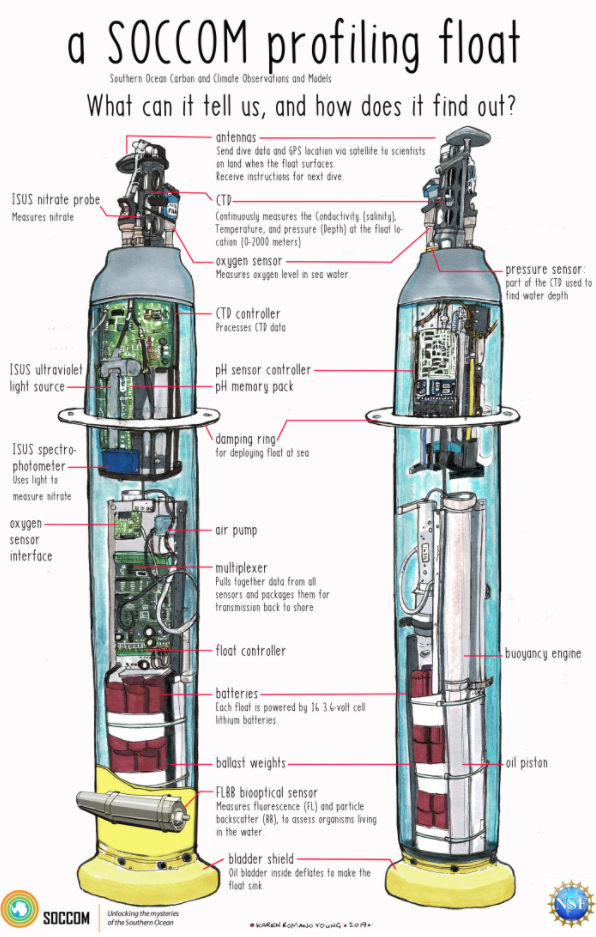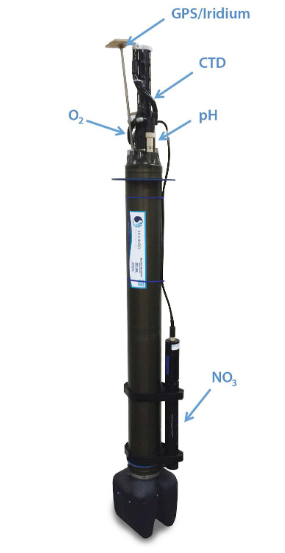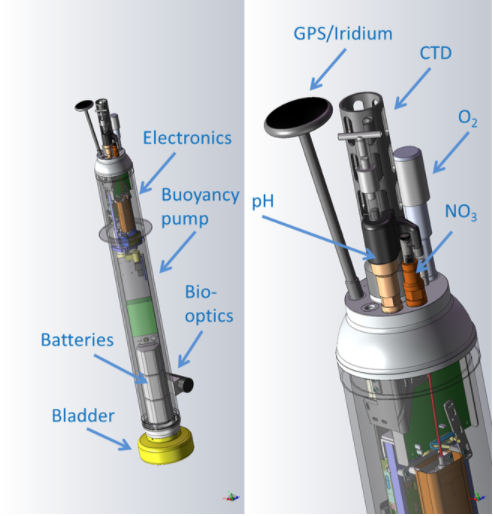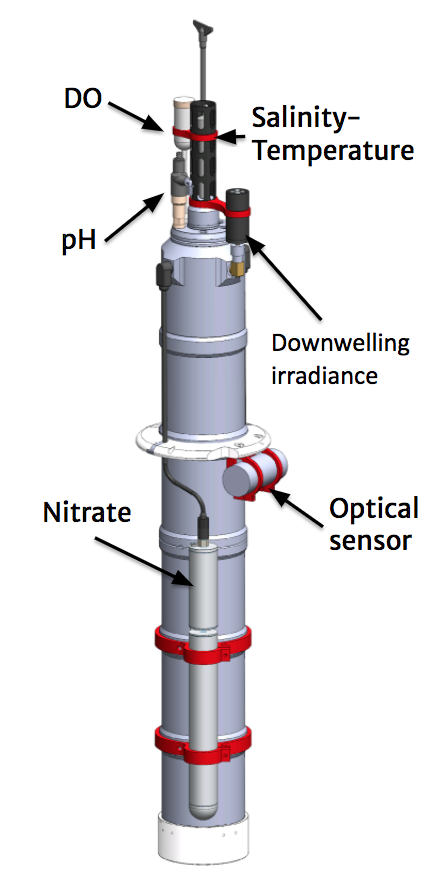Float Technology
Information on the Biogeochemical floats
used by the GO-BGC Array project
How Floats Work
A biogeochemical float spends its life drifting through the ocean, changing depth and collecting data at programmed intervals. It is battery-powered and hosts a suite of chemical and optical sensors. A typical cycle for a float is to descend to 1,000 m depth and drift for five to 10 days, then dive to 2,000 m before returning to the surface. It is able to dive and surface by changing its buoyancy, which is accomplished by pumping oil from inside the float to an external bladder and back. It collects data as it ascends, and when it reaches the surface, it transmits the data via Iridium communications satellites. It will repeat this cycle continually for as long as the batteries allow, about five years.
Floats and the global ocean observing system
This animation from the SOCCOM project shows how biogeochemical floats operate and fit into the global ocean observing system
Types of Floats
The GO-BGC Array is made up of floats produced by Sea-Bird Scientific (Navis), Teledyne Webb (APEX), and MRV Systems, LLC (Solo-II).
Float Sensors
The floats are equipped with a suite of sensors that gather information about the ocean. They measure several biogeochemical parameters, the data from which will help researchers monitor the health of the ocean. The sensors include:
CTD
A CTD measures Conductivity, Temperature, Depth. These parameters can be used to calculate the salinity and density of the water. When the float is ascending through the water column, the measurements it takes can show researchers where the different layers of water are, amongst other things.
Our sensors measure temperature within an accuracy of 0.001 degree C, pressure (closely related to depth) within 0.1 dbar, and calculate salinity using conductivity, temperature, and pressure within 0.01 PSS (Practical Salinity Scale).
Oxygen
Dissolved oxygen concentration is of both biogeochemical and physical oceanographic interest. Because phytoplankton production and community respiration processes influence the oxygen concentration, O2 can be used to quantify the Net Community Production in the surface. On floats, oxygen is measured with optode sensors. These sensors utilize an oxygen-sensitive foil or coating containing a luminophore, i.e., a substance that when excited with light of a certain wavelength (e.g., blue-green light) emits light with a different wavelength (e.g., red light). The optodes read the afterglow of the luminophore to determine the quantity of oxygen.
pH
Ocean pH is a dynamic variable that changes on daily, seasonal, interannual, and decadal to centennial time scales. Short-term variability is affected by a variety of processes including photosynthesis, respiration, heating, and ocean physics. Additionally, a century-scale decrease in surface ocean pH is driven by the long-term increase in atmospheric carbon dioxide created by combustion of fossil fuels. This long-term pH decrease, termed ocean acidification, may have profound effects on some organisms
GO-BGC Array floats measure pH with SeaFET™ Ocean pH Sensors. This sensor was developed by two members of the GO-BGC team, Lead PI Kenneth Johnson of the Monterey Bay Aquarium Research Institute (MBARI) and Todd Martz of the Scripps Institution of Oceanography, University of California San Diego.
Nitrate
Why measure nitrate? Nitrate is a key phytoplankton nutrient and its concentration regulates phytoplankton growth in much of the ocean. In a warming climate, the sea surface temperature also warms. Warm surface water and cold deep water stratify, or create “layers” of water, that inhibit the transport of cold, nutrient-rich, deep water to the surface where those nutrients would support primary production in the ocean.
The In Situ Ultraviolet Spectrophotometer (ISUS) is a sensor used to measure concentrations of dissolved chemicals directly from their Ultraviolet Absorption Spectrum (Johnson and Coletti, 2002). A variety of chemicals absorb light in the UV and each of these chemicals has a unique absorption spectrum. We can determine the concentration of these chemicals directly, with no chemical manipulation, by using the distinctive, ultraviolet absorption spectra of these chemical species. The sensor measures the absorption spectrum of seawater in the UV and then deconvolves the spectra to yield the concentration of each component.
Specifications & Telecommunications
The floats used by GO-BGC must produce climate-quality data records for carbon cycling, with the goal of tracking climate variability and change over time. The sensors used must be precisely calibrated to get the highest-quality measurements, and these data must be available in real time to allow inter-comparison of each float with the entire array so that sensor problems can be identified and re-calibrated. These adjusted data will be made available in near-real time to the greater community. The drawing below shows the components of a SOCCOM float, which is the same type that will be used for GO-BGC.




